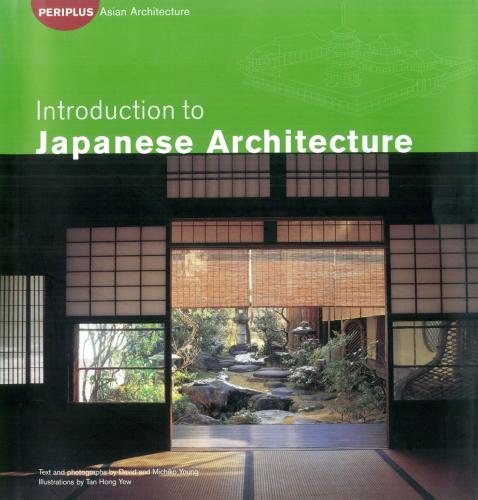Introduction to Japanese Architecture
text and photographs by David and Michiko Young
illustrations by Tan Hong Yew
Published by Periplus Editions (HK) Ltd
Text © 2004 David and Michiko Young
Illustrations © 2004 Tan Hong Yew
All rights reserved. No part of this publication may be reproduced, stored in a retrieval system or transmitted in any form or by any means, electronic, magnetic tape, mechanical, photocopying, recording or otherwise, without prior permission of the publisher.
ISBN: 978-1-4629-0809-7 (ebook)
Printed in Singapore
09 08 07 06 05 04
6 5 4 3 2 1
Distributors
Japan: Tuttle Publishing, Yaekari Building, 3F,
5-4-12 Osaki, Shinagawa-ku, Tokyo 141-0032
Tel: (813) 5437 0171; Fax: (813) 5437 0755
E-mail: [email protected]
Asia Pacific: Berkeley Books Pte Ltd,
61 Tai Seng Avenue #02-12, Singapore 534167
Tel: (65) 6280 1330; Fax: (65) 6280 6290
E-mail: [email protected]
North America, Latin America, and Europe:
Tuttle Publishing, 364 Innovation Drive,
North Clarendon, VT 05759-9436
Tel: (802) 773 8930; Fax: (802) 773 6993
E-mail: [email protected]
Photo Credits
Akita City, page 125 (No. 4); Murata Noboru, pages 91, 103; Nara Bunkazai Kenkyūjo, page 28; National Museum of Japanese History, page 54; Rekishi Kaidō Promotional Council, page 124 (bottom); Rinnōji Temple at Nikkō, page 98 (top); SANYO Electric Co. Ltd., Japan, page 125 (No. 1); Shiraoi Ainu Museum, pages 24, 25; Suzuki Toshikatsu, pages 118, 119, 120 (except left), 121; Luca Tettoni, page 120 (left); Toshitaka Morita, page 87; Michael Yamashita, pages 7, 11, 37, 50-51, 84, 126; Yoshinori Okayama, page 86.
Acknowledgements
We are especially indebted to Kansai Gaidai University, which has supported our research in a variety of ways and to Professor Kataoka Osamu who provided us with recent findings on prehistoric architecture. Other individuals who provided special assistance are Yoshimoto Norihito, Yoshinori Okayama, and Teresa Hurst. Institutions that were especially helpful are Ainu Minzoku Hakubutsukan (The Ainu Museum) and the Kokuritsu Rekishi Minzoku Hakubutsukan (National Museum of Japanese History). We would also like to thank the Imperial Household Agencies in Kyoto and Tokyo, the Izumi City Board of Education, Jingū Chōkokan (the museum affiliated with Ise Jingū), the Ise Shrine Office, Murōji Temple, Tōshōgū at Nikkō, the Rekishi Kaidō Promotional Council, Akita City, SANYO Electric Co. Ltd., and the many other institutions that provided us with information and pictures. Two books in Japanese that have been of special help are Nihon Kenchiku no Mikata (How to Observe Japanese Architecture) by Miyamoto Kenji and Shūfuku no Techō (Restoration Notes) by Bunkazai Kenzōbutsu Hozon Gijutsu Kyōkai (Japanese Association for the Conservation of Architectural Monuments). We are indebted to Murata Noboru, Suzuki Toshikatsu, Luca Tettoni, Toshitaka Morita, and Michael Yamashita, for granting permission to use their work to supplement photographs taken by the authors. Finally, we are grateful for the untiring assistance of our editor, Noor Azlina Yunus.
Contents
| Development of Traditional Architecture | 4 |
| Basic Principles of Japanese Architecture | 6 |
| Pre-Buddhist Cultures | 12 |
| Reconstructed Jōmon and Yayoi Settlements | 14 |
| The Grand Shrines at Ise | 18 |
| Tomb Mounds | 22 |
| Ainu Buildings | 24 |
| Influences from Korea and China | 26 |
| Heijōkyō: An Early Capital | 28 |
| Hōryūji: The Oldest Extant Temple | 30 |
| Nara Period Temples | 32 |
| Post-Buddhist Shinto Shrines | 34 |
| Developing a Cultural Identity | 36 |
| Palaces and Mansions | 40 |
| Mountain Temples | 44 |
| Paradise Halls | 48 |
| Merging of Shinto and Buddhist Architecture | 52 |
| The Way of the Warrior | 54 |
| New Principles in Residential Architecture | 56 |
| Kinkakuji and Ginkakuji Temples | 58 |
| The Way of Tea | 62 |
| Feudal Period Temples | 66 |
| The Ichijōdani Historic Site | 68 |
| Castles and Castle Culture | 72 |
| Centralized Authority | 76 |
| Edo: The Feudal Capital | 78 |
| Takayama: An Administrative Town | 80 |
| Kanazawa: A Castle Town | 82 |
| Ogimachi: A Farm Village | 84 |
|
Minka: Rural Houses
|
